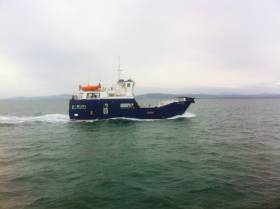Displaying items by tag: Leinster seaboard sea trials
Leinster Seaboard Trials Continue for Arklow Newbuild Northern Car Ferry
#SeaTrials – Off the Leinster seaboard an Arklow built car ferry contracted by Northern Ireland’s Department of Infrastructure continues to carry out sea trials today, writes Jehan Ashmore.
As previously reported on Afloat.ie the Spirit of Rathlin, a 6 vehicle /140 passenger capacity ferry was launched in September by Arklow Marine Services for the Ballycastle-Rathlin Island route.
The twin-screw car ferry with Belfast as a port of registry departed Arklow from where this morning the 28m long vessel with a beam of 8m is currently underway on sea trials.
Earlier this month the identity of the new operator of the Co. Antrim service to use Spirit of Rathlin following a procurement process was according to Dfi to be announced shortly.
It is rare to have an Irish built car-ferry as previously reported when the newbuild was hoisted from the North Quay in Arklow to be lowered into the River Avoca. The yard owned by the famous Tyrrell family whose generations have built small ships and boats at the shipyard stretching to 1864.
The yards founder John Tyrell opened the boatbuilding facility then on the south quays of the river. In more recent years one of the yard's most iconic vessels built was the brigantine Asgard II. This two-masted tallship was the Irish state’s first custom built sail training vessel launched in 1984.
In terms of car ferry construction the yard for example built in 1999 the Ikom K a 4 car / 60 passenger capacity ferry and likewise of Spirit of Rathin ordered for domestic service. The Ikom K though operates for clients in southern waters for owners Murphy Ferry Service linking Castetownbere to Bere Island, Co. Cork.





























































